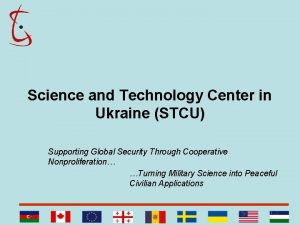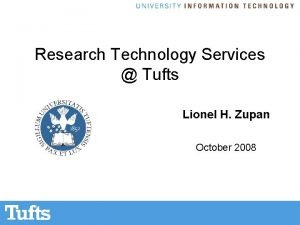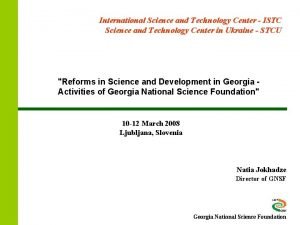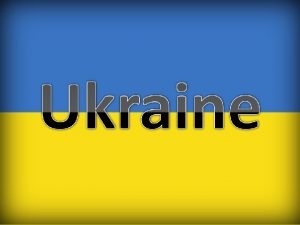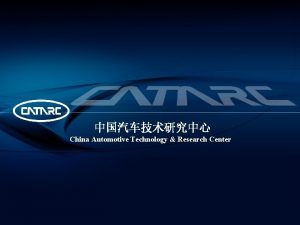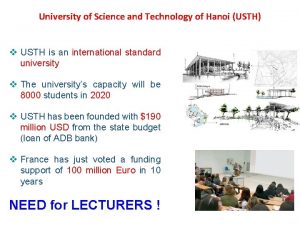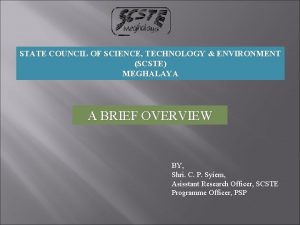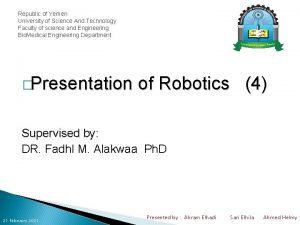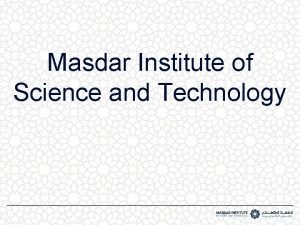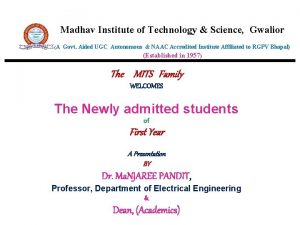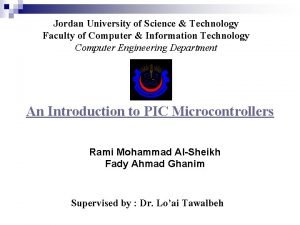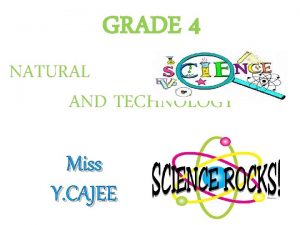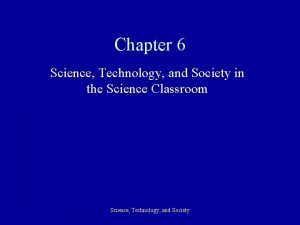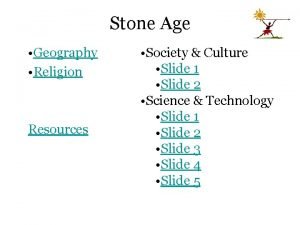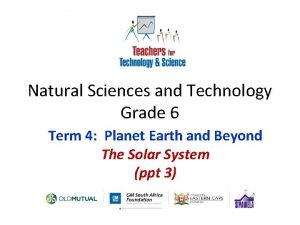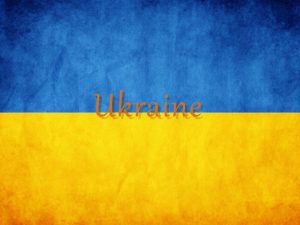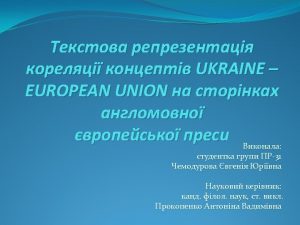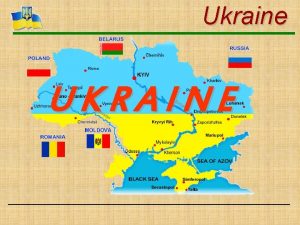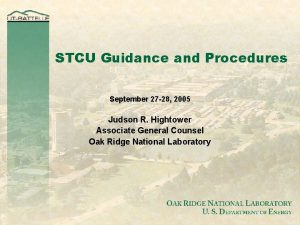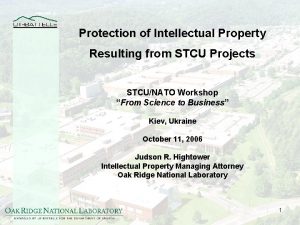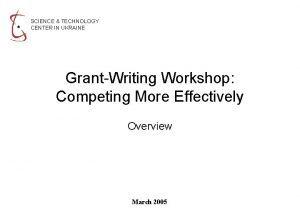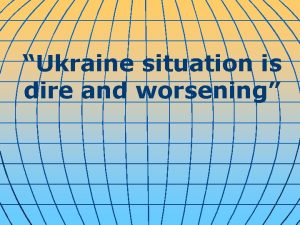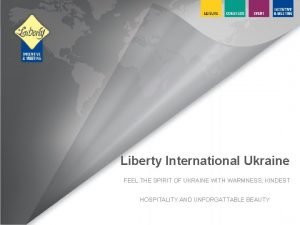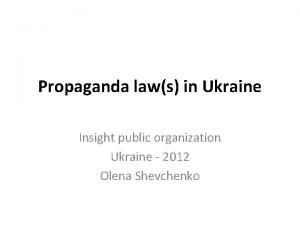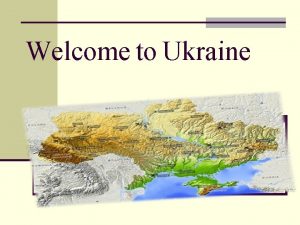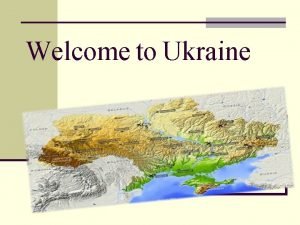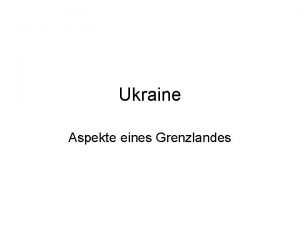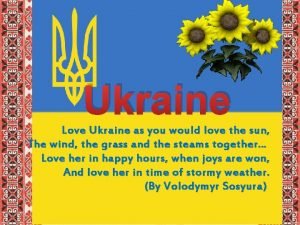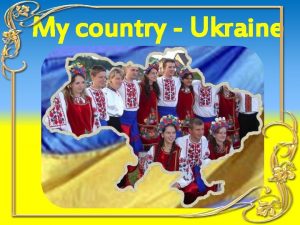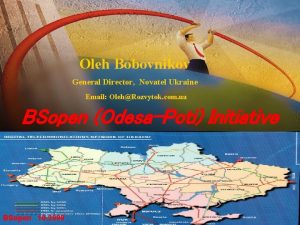Science and Technology Center in Ukraine STCU Supporting





















- Slides: 21

Science and Technology Center in Ukraine (STCU) Supporting Global Security Through Cooperative Nonproliferation… …Turning Military Science into Peaceful Civilian Applications

Our Mission: Nonproliferation of WMD Expertise • Engagement: Support multilateral, collaborative, peaceful civilian R&D activities that engage Azeri, Georgian, Ukrainian, and Uzbek scientists and engineers formerly involved WMD and delivery systems, so that their scientific talents contribute to solutions of national/international S&T problems. • Sustainable Redirection: Create opportunities former WMD scientists and engineers to develop sustainable, civilian research employment that contributes to their country’s to market economy transition, to science & technology development, and to deeper integration into the international community.

History of STCU 1992 – Negotiations Start on an S&T-Based WMD Nonproliferation Center Focused on ex-USSR military scientists & technicians 1993 - STCU is Established via Inter. Governmental Agreement Among Four Founding Parties: Ukraine, Canada, Sweden and the United States of America 1998 - European Union Replaces Sweden as an STCU Governing Party 2003 - STCU Surpasses $100 Million USD in Total Project Funding 2004 – STCU Governing Parties Agree to Focus STCU Efforts on Building Self-Reliance/Self-Sustainability of ex-USSR WMD scientists/institutes 2006 - Highest Annual Total in New Project Funding ($19. 4 Million USD) and Total Partner Project Funding (Approx. $10. 6 Million USD) 2007 – Highest Ever Annual Total in New Non-Governmental and New Partner Project Funding (Nearly $4. 7 Million USD)

STCU Operates In Five Recipient Countries Over 1, 000 Scientific and Technical Institutes Approximately 20, 000 -30, 000 Former Weapons Scientists (1995 informal est. ) STCU has engaged over 8, 300 former weapons scientists, plus 5, 000 other scientific personnel

STCU Has On-Site Presence Across Recipient States • Headquartered in Kyiv, Ukraine • Regional Ukrainian Offices in: – Dnipropetrovsk, – Kharkiv – Lviv Other Regional Offices in: – Baku, Azerbaijan – Tbilisi, Georgia – Tashkent, Uzbekistan – Chisinau, Moldova • 70 Person Staff – Multinational, Professional & Administrative

STCU Administers Sponsored Activities by Both Financing & Recipient Parties Canada Non. Government Partners E. U. Government Partners U. S. A. Science & Technology Center in Ukraine Azerbaijan Georgia Moldova Ukraine Uzbekistan

Making Progress, Seeing Results • Over 1100 Projects (approx. $168 Million USD equiv) since 1995 • Over 180 Partner Organizations (approx $60 Million USD equiv) – Over Half of All New Project Funding Approved in 2006 was for Partner Projects • Over 200 Patent Applications of STCU Project Results • Several Targeted Initiatives Addressing Issues of National/International Concern – Y 2 K Remediation Program – Various Government Threat Reduction Partner Programs – Jointly Financed Targeted Projects w/ Recipient Gov. Agencies – Sustainability Assistance

STCU Projects Help Convert Institutes Institute of Nuclear Physics (Tashkent) STCU Projects Compliment Institute Cooperation in Returning HEU Reactor Fuel – Projects to Create a Central Radioanalytic Laboratory and Mobile Labs (supporting of Uzbek Border Monitoring for Nuclear Material Trafficking) – Projects Develop Portal Monitor Technology for Radiological Material Detection – Three UK Closed Nuclear Cities Program funded Partner Projects Finance Market Research/Business Planning to Commercialize Institute Technologies Opening Ceremony, Central Radio-analytic Lab Institute of Nuclear Physics, Tashkent, UZ 5 October 2004

Partner Projects Develop Commercial & Non. Commercial Activities • US DOE Programs Combine Threat Reduction with Sustainable Transition through Partner Projects • DOE Partner Projects at Kharkiv Institute of Physics and Technology (KIPT): – One Project (DOE/Initiatives for Proliferation Prevention) Matches U. S. Industry Partner with KIPT to Establish a Commercial Medical Isotope Production Capability on KIPT Territory. – One Project (DOE/Global Threat Reduction Initiative) Finances DOE and KIPT Experts to Design New Laboratory Set-Ups that will use Low Enriched Uranium instead of Highly Enriched Uranium.

Ex-Weapon Scientists Help in Safe Dismantlement (PMF-1 Series Anti-Personnel Mines Evaluation Project) • • • Project Organized by STCU, Funded by EU (€ 400, 000), to Evaluate Destruction Technologies for Environment & Health Risk Around 6 mil PFM-1 Type Mines in Ukraine, All containing Toxic Liquid Explosive Chemicals Mines Also Stored in Other CIS and Eastern European Countries Handling and Transport of the Mines is within usual industrial levels. Common Arms Reduction Support (CARS) Fund No Open Air Destruction of the Mines Should Take Place.

Government Programs Make Use of STCU Over 20 Government Partners including: • • Max Planck Institute of Plasmaphysics (Germany) UK Department of Trade and Industry U. S. Department of Energy/Initiatives for Proliferation Prevention (IPP) Lawrence Livermore National Laboratory (USA) U. S. National Institutes of Health/National Cancer Institute U. S. Environmental Protection Agency U. S. Department of Agriculture/Agricultural Research Service U. S. Department of Defense/Defense Threat Reduction Agency

Non-Government Partners: Contributing to Self-Sustainability Over 160 Non-Government Partners including: • General Electric Corp. (USA) • PPG Industries, Inc (USA) • The Boeing Co. (USA) • Intel Corp. (USA) • AECL Chalk River Laboratories (Canada) • Medteknostics, Inc. (Canada) • Airbus (UK) • Scionix Holland A. V. (Netherlands) • Michelin Corp. (France)

Targeted R&D Initiatives: Creating Equal Partnerships • Co-financing of Projects Selected by Recipient Party Government and STCU – Focus on Recipient Party National S&T Priorities and STCU Nonproliferation Mission • First TRDI (2005): STCU – Ukraine – $500 K in STCU Party Funds and $500 K from NASU = $1 Million in Projects – 3 Rounds Completed • • Over $3 Million in Co-Financed Projects Two More Initiatives Underway – Georgian National Science Foundation – Azeri National Academy of Sciences STCU-NASU Cooperation Agreement Signing Ceremony – Kyiv, 26 May 2005 TRDI Creates Equal Partnership, Vested Interest, and Leveraged Funding Between Donor & Recipient Parties

Transition from Military to Civilian R&D Takes Time & Constant Effort After 12 Years, STCU Recipients Still Working on Becoming Self-Reliant in Non-Military Research

STCU In the Future Near-Term: Continue “Permanent Redirection” Phase of Mission Partner Projects Increasing Share of STCU Activities More Focus on Opportunities in: • Diversify Institute Research Income Sources • Tech Transfer/IPR Capability Improvement • Partner with National/International Science Programs • Increase Involvement of Recipient Parties as Equal Contributors Long-Term: Under Discussion

Contact Information Science and Technology Center in Ukraine (STCU) 21 Kamenyariv St Kyiv, Ukraine 03138 Tel: +380 -44 -490 -7150 Fax: +380 -44 -490 -7145 E-mail: stcu@stcu. int Web site: www. stcu. int

BACKUP SLIDES: FOR INFORMATION

Science Centers Strategic History 1992 - 2004 Threats Goals Spread of FSU WMD Expertise due to Social /Political Breakdown, Unemployment Stabilize FWS Situation in situ Strategy Engage FWS in Coop. Research Grants Response ISTC/STCU Regular Projects plus Supporting Activities (Travel Support, Training, Workshops, etc. ) 2005 - 2012 Dependency on Science Center Resources; Return to Weapons Research or Unemployment Redirect FWS into Self-Supporting Peaceful, Employment Develop FWS in Self-Sustainability. Integrate FWS into National or Regional S&T Programmatic Efforts ISTC/STCU Programmatic Activities plus Partner Programs and “Evolution to Partnership” With Beneficiary Member Countries 2012 - ? ? Ad Hoc, Politically-Sensitive Issues; Unstable Socio-Economic Development; S&T Competitive Erosion Develop Avenues for Multilateral S&T Responses to Politically Sensitive Problems/ Regional & Global Threats, Regional Stability Flexible, Multilateral S&T Tool to Respond to Broad S&T Needs/Sensitive Tasks? Broaden ISTC/STCU Mandate Beyond FSU WMD Scientist Redirect Mission?

STCU Projects in Nuclear Safety Support to Ukraine • 50 STCU Nuclear Safety-Related Research Projects in Ukraine – Including Material Research, Material Accountability Projects – 7 Nuclear Safety-related Projects in Uzbekistan • Over $6. 7 Million and over € 640, 000 Committed • Projects Include the Following Areas of Research: – Nuclear Database for Chornobyl NPP Decommissioning Activities – Electro-reclamation Systems for Decontaminating Water and Soils – Low-level Nuclear Waste Container Designs – High-Level Waste Partitioning Technologies – High-sensitivity Scintillation Detectors for Remote Monitoring of Radiation Environments – Development of a Monochromatic X-ray Locator for the Nuclear Material Control and Monitoring

Y 2 K Remediation of Ukrainian NPPs • Special Targeted Program to Address Y 2 K Readiness Problems at Ukraine’s Nuclear Power Plants –Initiated in April 1999: STCU, Energoatom, NPP Operational Support Institute, and U. S. Do. E International Nuclear Safety Program (Pacific Northwest National Lab) – Over $1. 7 Million and € 342, 022 Contributed by STCU Parties Plus a Special $20, 000 Contribution from the Netherlands • Eight Special STCU Projects Implemented between April and 31 December 1999 to Assess, Remediate, and Develop Contingency Plans –More than 300 Ukrainian Specialists from Five NPPs Participated. STCU provided Overall Coordination, Technical Monitoring, Financial Support and Auditing. • All Projects Were Successfully Implemented Before the Target Rollover Date, with 38 Safety Critical Systems Remediated – One Western Expert Noted: “Some Countries Performed Well, But No Country Performed Better than Ukraine. ”

Total Former Weapon Scientists (FWS) in STCU Project/Proposal Records (All Countries) 1995 Informal Estimate from Ukrainian GB member = 20, 000 -30, 000 Scientists with military R&D background
 Mail @ stcu.int
Mail @ stcu.int Tufts science and technology center
Tufts science and technology center International science and technology center
International science and technology center Science fusion online
Science fusion online My favorite subject is biology
My favorite subject is biology Whats ukraines religion
Whats ukraines religion Missoula technology development center
Missoula technology development center China automotive technology & research center
China automotive technology & research center Carver center for the arts and technology
Carver center for the arts and technology University of science and technology of hanoi
University of science and technology of hanoi Unist application fee
Unist application fee Scste meghalaya
Scste meghalaya Science and technology university yemen
Science and technology university yemen Masdar institute of science and technology
Masdar institute of science and technology Madhav institute of technology and science
Madhav institute of technology and science Jordan university of science and technology
Jordan university of science and technology Jordan university of science and technology
Jordan university of science and technology Natural science grade 4 term 2 practical tasks
Natural science grade 4 term 2 practical tasks Sts chapter 6
Sts chapter 6 Adverb of science
Adverb of science Stone age science and technology
Stone age science and technology Term 4 natural science grade 6
Term 4 natural science grade 6
